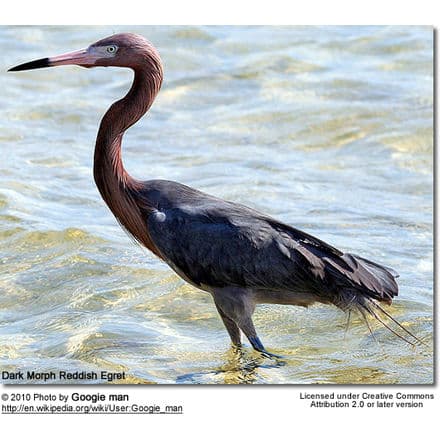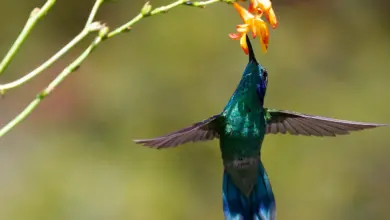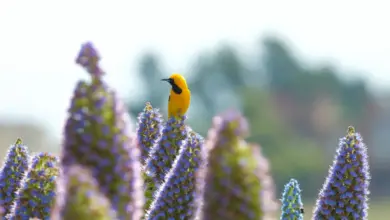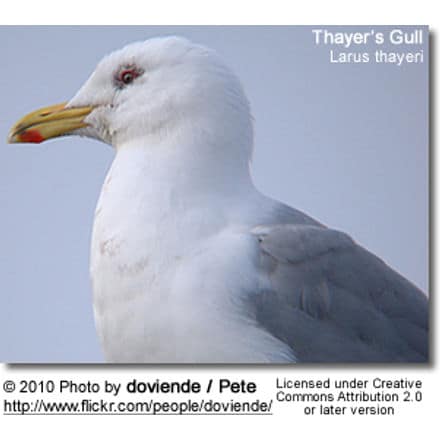Reddish Egrets
The Reddish Egrets (Egretta rufescens) – also commonly referred to as Dickey’s Egret or Reddish Heron – is a medium-to-large heron. It is mostly active at dawn and dusk.
Notwithstanding its name, Reddish Egrets occur in a white phase – with white plumage – and a dark phase – with a reddish or rusty-colored head and neck. The white phase was formerly thought to be a completely different species.
The dark phase is far more common than the white phase – which makes up less than 20% of the total U.S. population.
Alternate (Global) Names
Danish: Rusthejre … Dutch: Roodhalsreiger … German: Blaufußreiher, Rötelreiher … English: Dickey’s Egret, Reddish Egret, Reddish Heron … Spanish: Garceta Rojiza, Garza Morada, Garza Roja, Garza Rojiza … Finnish: Klovnihaikara … French: Aigrette rousstre, Aigrette rousse … Italian: Egretta rossiccia, Garzetta rossastra, Garzetta rugginosa … Japanese: akakurosagi … Lithuanian: Rudakaklis garnys … Norwegian: Dansehegre … Polish: czapla rdzawoszyja … Russian: ??????????? ?????, ??????? ????? … Slovak: volavka strapatá … Swedish: Rosthäger … Chinese: ???
Distribution / Range
The Reddish Egret can be found on the Gulf Coast in Texas and some parts of Louisiana, as well as along the Gulf and Atlantic coasts of southern Florida
It also occurs in Mexico, the Caribbean islands, the coast of northern South America, and the West Indies. This species is rare along the Gulf Coast of Mexico, the West Indies, and Baja California.
In some areas, they are permanent residents, for example in Central America, the Bahamas, the Caribbean, the Gulf Coast of the United States, and Mexico.
Most breeding takes place along northern coastlines. Non-breeding birds may disperse to the south in the Caribbean and along the Pacific coast.
They are native to the following countries:
Anguilla, Antigua and Barbuda, Aruba, Bahamas, Barbados, Belize, Cayman Islands, Colombia, Costa Rica, Cuba, Dominica, Dominican Republic, El Salvador, Guadeloupe, Guatemala, Haiti, Honduras, Jamaica, Martinique, Mexico, Montserrat, Netherlands Antilles, Nicaragua, Panama, Puerto Rico, Saint Kitts and Nevis, Saint Lucia, Saint Vincent and the Grenadines, Trinidad and Tobago, Turks and Caicos Islands, United States, Venezuela
They are vagrants to:
British and US Virgin Islands

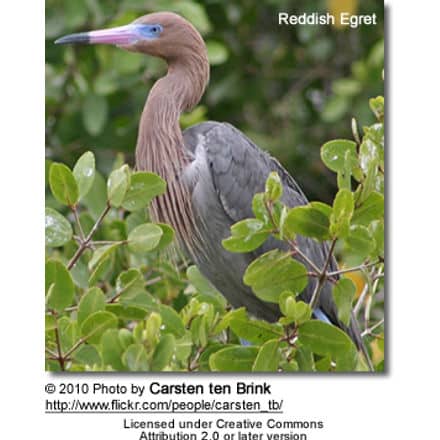
Habitat
Reddish Egrets are usually observed near or in salt and brackish water wetlands. They frequent shallow coastal waters, salt pans, open marine flats, and shorelines. They are rarely found inland.
They breed on islands and in mangroves.
Description
The Reddish Egret measures 27 – 32 inches (68 – 82 cm) in length, with an approximate wingspan of 46–49 inches (116–124 cm). The average weight is 24.7–30 oz (700–850 g).
They usually hold the neck in an “S” shape (during flight and when resting). Their long legs and feet are bluish-black in color. Their pointed pinkish bill has a dark tip.
Adults in breeding plumage have long plumes on their heads and necks.
The Reddish Egret comes in two color forms (morphs or genetic mutations):
-
- The adult dark morph has a dark grey plumage, with a reddish head and neck with shaggy plumes.
- The adult white morph has an all-white plumage. Juveniles are mostly brown.
Gender id:
Males and females look alike.
Immature Description
Juveniles resemble the adults, but the dark phase birds have paler and duller plumage.
Similar species
The White-phase Reddish Egrets could be confused with the following species:
- The Cattle Egret usually has a reddish wash over the head, back, and chest. It is also much shorter and stockier than the Reddish Egret and has a thick, usually yellow bill.
- The Snowy Egret is smaller and more slender. It has a black bill, yellow feet, and a distinctive yellow skin patch from the eye to the bill.
- The Great Egret is larger in size and has a mostly yellow bill. The legs are black.
- The Great White Heron is much larger and has a heavier bill without a dark tip.
The Dark-phase Reddish Egrets could be confused with the following:
- The Tricolored Heron is a little smaller and thinner. It has white head plumes, a white line down the throat, and a white abdomen.
- The Little Blue Heron has a less reddish neck and head, sleeker neck feathers, and a bluish base to the bill. Immature Little Blue Herons have dark-tipped bills with a greyish base. The legs are green. The neck is more slender and not shaggy.
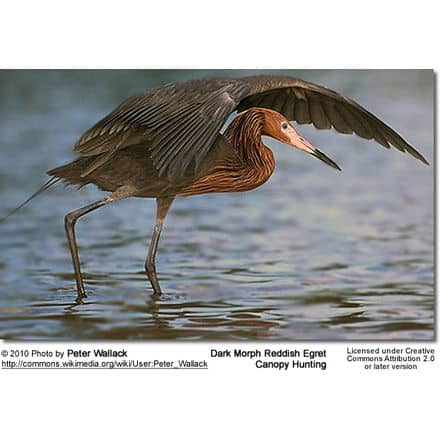
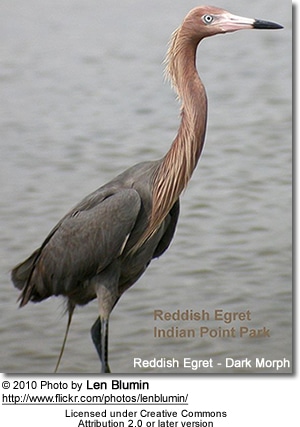
Diet / Feeding
The active Reddish Egrets are often observed running, jumping, and spinning in pursuit of their prey, which includes fish, frogs, tadpoles, crustaceans, and insects
They stalk their prey visually in shallow water, sometimes curving their wings forward around the body to make a canopy thus reducing glare on the water and making it easier for them to see their prey.
Reddish egrets use their long, spear-like bills to stab their prey.
After feeding, they regurgitate all the inedible parts of their prey, such as bones.
Parents feed their chicks by regurgitating food into their mouths.
Reproduction
Reddish Egrets reach reproductive maturity when they are about three to four years old.
Breeding activities are observed in almost all months of the year; however, there are definite peaks that vary in timings across their range. In the United States, most breeding activity is observed from early March through late July.
Their courtship displays involve shaking of the head, followed by chases and circle flights. They also raise the neck, back, and crest feathers, accompanied by bill clacking. During mating, the male’s plumage stands out in a ruff on its head, neck, and back.
Their breeding habitats are tropical swamps and coastal islands; where they nest in colonies, often with other herons, egrets, cormorants, and spoonbills.
Both the male and the female construct the platform nest together out of sticks. They continue to add sticks during the incubation period. The nest may be up to 10 inches (25.4 cm) thick with a diameter of 12 to 26 inches (30 to 66 cm). The nest is either situated on the ground, in mangroves, in shrubs, or in trees up to 20 feet (6 m) high.
The female lays 3 or 4 smooth, pale blue-green eggs with no markings. Both parents incubate the eggs for about 25 – 26 days. The parents also raise the chicks together. Two white-phase parents only produce white-phase chicks; however, dark-phase parents can have both dark-phase and white-phase chicks. If one parent is white-phase and the other dark-phase, their chicks are almost always dark-phase. The young fledge when they are about 45 days old.
The young and eggs are preyed on by raccoons, coyotes, and great-tailed grackles.

Calls / Vocalizations
The Reddish Egret’s call is described as a low, guttural croak.
Lifespan
Reddish egrets can live up to 12 years.
Status / Conservation
In the late 1800s and early 1900s, the Reddish Egrets were hunted for their feathers, which were used to decorate ladies’ hats and clothing.
Their populations were nearly exterminated in the United States due to overhunting, and they disappeared from some areas entirely (for example Florida).
Since 1918, this species has been under the protection of the Migratory Bird Treaty Act and their numbers are slowly increasing.
Current threats include habitat disturbances and destruction; as well as environmental pollutants, such as pesticide runoff.
The Texas Parks and Wildlife Department estimates that there are only 1,500 to 2,000 breeding pairs in the United States – and most of them in Texas. They are, therefore, classified as “threatened” in Texas.
Population estimates are as follows:
- 954 and 1,260 breeding pairs on the Pacific coast
- 1,000 pairs at Green Island, Texas, and 200 – 300 pairs in other areas in Texas
- Less than 200 pairs at Tamaulipas, Mexico (Laguna Madre)
- 50 pairs at Inagua, Bahamas, and 50 pairs in other areas in the Bahamas
- Up to 200 pairs in Florida
- Up to about 5,000 resident birds in Belize
- Unknown numbers occur in Cuba and the Dominican Republic.
- The estimated global number of this species is 10,500-11,300 mature Reddish Egrets
